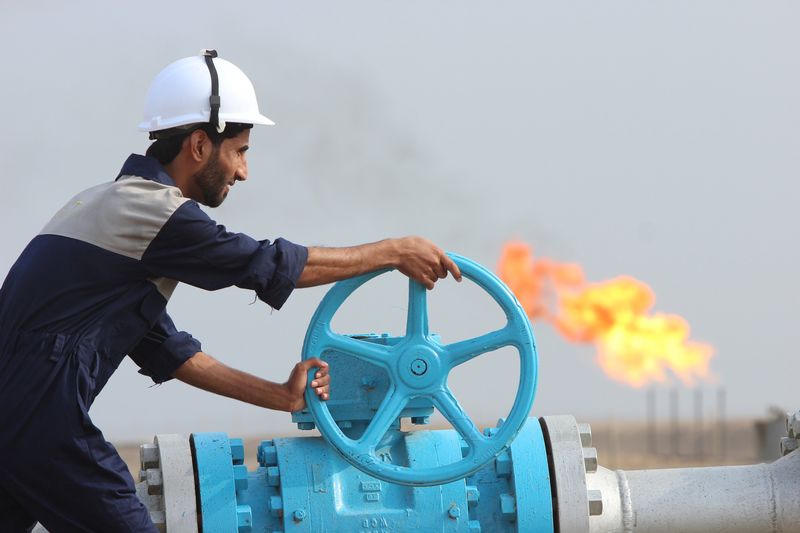Investing.com -- The Saudi quest to get to $90 oil came through on Tuesday when the kingdom, in an announcement synced with allies Russia, said the million-barrels-per-day cut it introduced in July will be enforced till December, with the Kremlin contributing an additional 300,000 barrels daily.
The total daily reduction of 1.3 million barrels till the year-end had not been anticipated by most traders — many had expected a month-by-month announcement — and the maneuver designed to unnerve the market to the upside achieved its desired effect.
London-traded Brent settled at $90.04 per barrel, up $1.04, or 1.2%, on the day. It earlier hit a session peak of $91.14, its highest since August 2022. Last week Brent rose 4.8%. That was after a combined 2.3% drop over two prior weeks. Even before that, the global crude benchmark rose for seven weeks in a row, gaining a total of 18%.
New York-traded West Texas Intermediate, or WTI, crude settled up $1.14, or 1.3%, at $86.69 per barrel after a 10-month peak at $88.03. That extended last week’s 7.2% gain for the U.S. crude benchmark. Prior to that, the WTI experienced a combined 4% drop over two weeks as the economy in top oil importer China sputtered. Even before that, WTI gained 20% over seven weeks.
Despite the slow start this week, momentum remains with the rally,” Craig Erlam, analyst at online trading platform OANDA, said, remarking on the weak pricing for both Brent and WTI earlier on Tuesday before the market hype over the cuts.
Oil’s race to $90 happened with less than three weeks left for summer, the season Americans like driving the most. With the fall season of lower oil usage set to begin on Sept 23, crude prices would typically retreat a little, sometimes meaningfully, in the world’s largest consuming country.
But that may not happen this time, not with the Saudi obsession of ultimately getting oil to $100 a barrel or beyond. The Arabs, who control much of the world’s oil exports, have been fixated on triple digit pricing since losing that advantage in August 2022, when Brent crude hovered above $105. Prior to that, the global crude benchmark reached nearly $140 in March last year, right after the Russian invasion of Ukraine.
The question is whether demand will be supportive to sustain such pricing, a challenge the Saudis are trying to meet in a different way.
As suggested earlier, with the advent of fall, or autumn, U.S. driving activity will begin to lessen and the deceleration will heighten as the weather gradually turns colder, heading into the winter months. The chill will, of course, bring its own attendant demand for heating. Even so, the period between now and late October/early November, known as the ‘shoulder season’ between end-summer and advanced fall, typically sees less demand for oil and, correspondingly, lower prices for crude.
But the Saudis and Russians, and their allies in the Organization of the Petroleum Exporting Countries, or OPEC, are planning to cut as many barrels from production and exports as necessary to defy market norms.
While demand is usually the driver for the pricing of anything, in this case, the Saudis and their allies are using supply to overwhelm the buying component in the oil market to skew market balance in their way. The idea is to create such an artificially short supply that the trade simply cannot function in a normal way.
Key to this is the one-million-barrels-per day in additional cuts, on top of other existing production rationing, that the Saudis have been carrying out since July. By extending this till the year-end — and widening it with Russian help — the kingdom is hoping to create a different sort of market phenomenon for pricing.
“Everyone’s looking at the flat price of crude oil and saying gasoline and diesel prices will also go to the moon,” said John Kilduff, founding partner of New York-based energy hedge fund Again Capital. “But fuel uptake for this summer is still very much down to earth, higher than a year ago, yes, but still below pre-pandemic levels.”
“You have an odd situation where the Saudis are trying to create a supply situation even lower than the seasonal lows in demand,” Kilduff continued. “All I’ll say is don’t test the mettle of consumers and the global economy because when either collapses, your dream of higher and higher prices will also go with that.”
The four-week average of U.S. gasoline consumption — the best gauge of fuel demand — was at 9.033M barrels per day for the week ended Aug. 25 versus the year-ago level of 8.874M.
But consumption is still well below pre-pandemic levels, with 9.777M barrels used daily for the comparative week to Aug 23, 2019.
In China, government and private surveys offered mixed signals on manufacturing activity, as the world’s largest oil consumer struggles to shore up a post-COVID economic recovery. Those long oil are, instead, hoping that Beijing will release more stimulus measures in the coming weeks to further support growth. Focus this week is also on Chinese trade data to gauge just how well crude demand is holding up in the country.
Some are looking at the start of the North Atlantic hurricane season as one factor that could be supportive for oil, especially if there are serious disruptions in production and damage to oil installations in the US Gulf Coast of Mexico. But history has been on the kinder side of late to America where hurricane damage is concerned.
(Peter Nurse and Ambar Warrick contributed to this)
